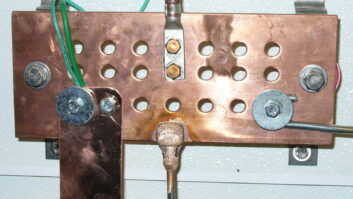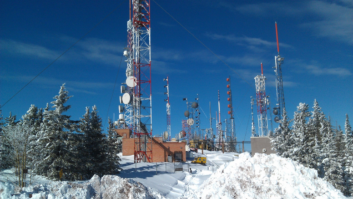John Stortz of the Moody stations in Florida protects his VRC-2000 remote control from the southern lightning by using an Optilator from Stormin’ Products, available through most broadcast equipment vendors.
This device interfaces your remote control to the telco world by isolating the copper phone line through a few inches of fiber-optic cable. The risk of lightning damage, coming in from the phone line, virtually is eliminated.
Recently, however, John’s Optilator at WKES(FM) failed. Talking to Mr. Optilator, John Pencore, at Stormin’ Products, John learned of a situation that can occur. He passes it on to Workbench readers.
The WKES remote control normally is used only to call out alarm conditions. Because there are few alarms at this site, the call-out feature is used rarely. There is a rechargeable battery on the line side of the Optilator, which must be charged while the phone is off-hook. If the battery discharges too much, there will be no dial tone passing through the Optilator.
To overcome the problem, the Optilator has a black, recessed switch on the telco end of the unit that can force the device to connect to the phone line. Pressing and holding this switch for about 20 seconds will recharge the battery enough to get a dial tone and place a call. If this works, leave the Optilator connected to a phone that is off-hook for about 20 minutes, and the battery should recharge.
We thank both Johns for this tip. This occasional maintenance procedure is a small price to pay for the protection this device offers dial-up remote control systems.
(click thumbnail)Fig. 1 How are your coaxial grounds?

. . .
How are your coaxial grounds? Fig. 1 shows the proper method of attachment. Note how the ground kits sweep down from the coax toward the ground plate.
I can’t begin to tell you how many I see that loop or connect “up” only to loop back down to ground. Remember, the purpose of the ground kits is to provide an easy path to ground. Lightning will seek the easiest path to ground; the sweep from the line down to the ground plate in the photo achieves this.
Note also that the ground wire leading from the ground plate is protected by a piece of PVC pipe (see arrow).
Thanks to Jeff Caudell, Harrisonburg market engineer for Clear Channel, for sharing how it’s done right.
. . .
(click thumbnail)Fig. 2 Crushed line like the one on the left can cause VSWR problems. Keep lines clear of climbing pegs or ladders.
While we’re on the subject of transmission line, Fig. 2 shows what can happen when line is not mounted properly on a tower. Looks like the line on the left was used as a climbing step!
Crushed line, as seen here, can affect your voltage standing wave ratio – VSWR – or reflected power; and the higher the frequency, the bigger the effect.
Protect cables by mounting them properly to the tower, keeping them clear of climbing pegs or ladders.

. . .
Radio World’s online NewsBytes recently carried a story about theft of transmission line at a Citadel tower site in Spokane, Wash. Thieves hacked off about 250 feet of line from a 10-foot spool of Andrew 3-inch Heliax, a crime that cost the station about $14,000 in materials and crew time.
The station’s misfortune brought some hard-earned suggestions from Entercom-Seattle’s Clay Freinwald to the SBE-PDX newsletter of SBE Chapter 124 in Portland, Ore. One of Clay’s stations recently was hit as well; several hundred feet of 3- and 5-inch line was stolen.
Some was retrieved when an alert policeman spotted a truck with a piece of the line sticking out of the back. But, Clay writes, the owners did not get all of it back; and what was retrieved had been cut into 8-foot lengths. Scrap-metal dealers will pay about 40 cents per pound for line – with the jacket on.
In the end, Clay had his line transported to the scrap yard and got a check for a few hundred dollars.
After that experience, Clay offers the following suggestions: If you have transmission line on the ground, keep the spools in a locked yard with an alarm. Keep the spools covered with a large tarp. But, better yet, keep the spools out of sight, if possible.
. . .
We’ve had a few tips recently about jumper and test cables. The time spent on making up an assortment of cables is always appreciated when you’re under the gun to get something tested in a hurry.
Joe Schloss of KICD(FM) in Spencer, Iowa, suggests taking the step further. He writes, “It costs next to nothing!”
Take an assortment of DB connectors – male and female DB-9s, -15s, -25s and -37s. Get some existing jumpers from your workbench and cut them in half. Solder the jumper to each mating male/female pair.
The adapters will give you an easy way to hook a VOM or other device to a DB port to pick up a temporary audio feed.
(click thumbnail)Fig. 3 The American Museum of Radio in Washington state includes this Wurlitzer Juke Box that plays 78s using a fixed tone arm.

. . .
If you’re planning to attend the NAB Radio Show in Seattle next month, build an extra day into your schedule to drive up to Bellingham, Wash. There you will find the American Museum of Radio at 1312 Bay Street.
Fig. 3 will greet you as you enter the museum. It’s a late-1930s Wurlitzer Juke Box, Model 258, and it would make Dick Clark proud. It plays only 78-rpm records and holds 24 tunes.
What’s unique about the design is that the tone arm is fixed and the turntable moves up and down vertically, bringing the record up to the stylus, then lowering the record to its appropriate location after playing. It’s ingenious, and the jukebox still works.
The museum features an abundance of radios, early vacuum tubes, meters and amplifiers. Admission is free, donations are appreciated. Note that the museum is open Wednesdays through Saturdays from 11 a.m. to 4 p.m., and by appointment. For information call (360) 738-3886 or go online to www.americanradiomuseum.org.
It’s another reason to “see you in Seattle.”












